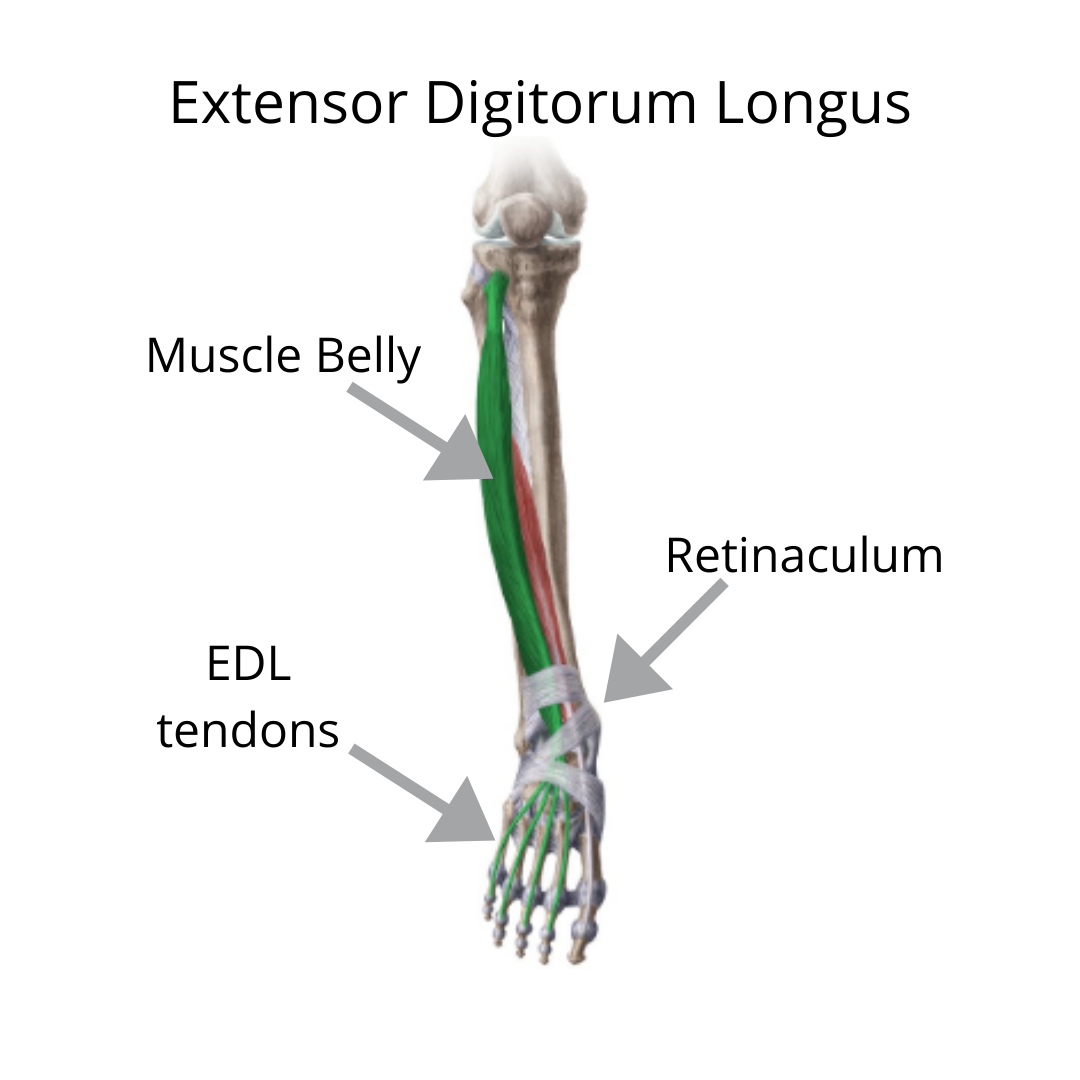Pain on the Top of the Foot: Extensor Digitorum
A frequent complaint from runners is pain on the top of the foot. Although things like stress fractures can occur, it’s not common unless there is a traumatic event. More often than not, it’s a problem with the extensor mechanism of the toes. Either the tendons get inflamed, or the sheath they slide in and out of gets inflamed. The muscle in question in the extensor digitorum longus. Here is what it looks like:
You’ll notice that the tendons insert on all of the toes except the big toe. There is also a retinaculum which is a piece of connective tissue on the front of the ankle that keeps the tendons from bowstringing, and acts as a fulcrum point. The muscle acts to lift the toes up, assists with dorsiflexion and eversion of the foot.
If you are swollen and bruised, you should consult with a physician. When there is bruising, blood vessels have been interrupted, and is a sign (although not always) of tissue damage. This could be rupture of a muscle or ligament, or a stress fracture. If it’s just swollen and not bruised, it’s more likely that you have an overuse injury such as a tendonitis or tenosynovitis.
So why does this happen? This can occur when running hills, up stairs, or in the case of a friend of mine, when running the warped wall in a ninja obstacle course. All of these motions require you to forcefully lift your toes and foot upward so you don’t trip. There are, of course, contributing factors that can lead to any overuse injury, and with ankle injuries, lack of dorsiflexion is usually an underlying culprit.
With this particular situation, lack of dorsiflexion will lead to foot eversion. In other words, your foot will turn out when you run to make up for the lack of motion required to run. This puts the extensor digitorum into a shortened position which is a great way to strain it. Also, if you are restricted in dorsiflexion, the muscles in the front of the foot, including extensor digitorum, have to fight against the tissue resistance, also leading to strain. It’s like running with a hand brake on. So the long term fix will be to restore your ankle dorsiflexion and work on your landing mechanics so that you run and land with your foot straight.
But if you are dealing with this, and it can be exquisitely painful, you will first want to get out of pain and feeling normal. Here is where we use the D2R2 model:
Step 1: (D1) Desensitize. This can be done with massage, cupping, scraping, etc. Anything to reduce pain levels
Step 2: (D2) Decongest. Get the static fluid out of the area. Intermittent compression works great with this step. We recommend voodoo flossing like so:
You can also do the same thing with the wrap going over the top of the foot to address the tendons. If you are still swollen, use the effects of gravity. Lay on your back with your legs up on a wall. Pump your ankles 30 times. Then contract your quads 30 times, then contract your glutes 30 times, then take 10-20 deep breaths. With each inhale, make sure your belly rises, and then descends on exhale. This is a great way to get movement through your lymphatic system which is your drainage system.
Step 3: (R1) Reperfuse. Get new blood into the area. You can do this with pain free movement.
Step 4: (R2) Restore. Normalize your range of motion and strength to the area.
Here is a video of steps 3 and 4:
Once everything is back to normal, start working on getting full ankle dorsiflexion back like so:
Want to work on your ankles at home? Check out our ankle program.


